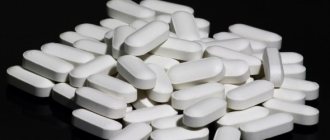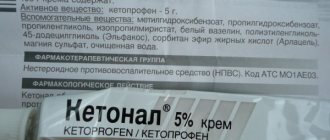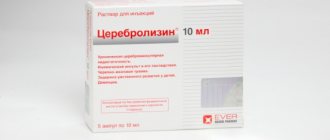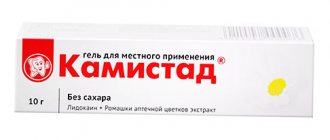Pharmacological properties of the drug Ultop
Ultop belongs to a group of drugs that inhibit the secretion of gastric juice, but do not have an anticholinergic effect and are not an H2 receptor antagonist. On the surface of gastric parietal cells, omeprazole specifically binds to the enzyme H+/K+-ATPase, known as the proton pump. This binding is irreversible. Omeprazole inhibits the activity of the proton pump, which manifests itself in the final stage of the process of gastric juice secretion. The drug reduces basal and stimulated secretion, regardless of the nature of the stimulus. The effect of omeprazole is dose-dependent. The effect of proton pump inhibition appears within 1 hour and reaches a maximum after 2 hours. After a single dose of the drug, the effect lasts 70 hours. When taking repeated doses, the effect increases during the first 4 days and then reaches a constant level. After completion of treatment, secretory activity returns to normal within 3–7 days. Basal secretion of hydrochloric acid decreases by 78% with regular use of the drug at a dose of 20 mg; it can be reduced even by 94% with regular use of the drug at a dose of 40 mg. Gastric acidity decreases by 80–97% after taking omeprazole 20 mg and by 92–94% after taking 40 mg omeprazole. A 50% reduction in hydrochloric acid secretion persists throughout the day. Maximum serum concentrations are achieved 0.5–3.5 hours after oral administration. Concentration and bioavailability are approximately proportional to the amount of the drug taken, but when taken in high doses, this proportionality is disrupted (due to saturation of the metabolic capabilities of the liver and/or due to increased absorption, depending on the acidity of gastric juice). Omeprazole is rapidly metabolized in the liver. The bioavailability of omeprazole after a single dose of 20 to 40 mg is 30–40% and increases slightly with repeated doses. The low bioavailability of omeprazole is mainly due to pre-systemic metabolism. Bioavailability increases slightly in elderly patients and in patients with impaired renal function and increases significantly in patients with chronic liver dysfunction (in such patients, the bioavailability of omeprazole can reach 100%). Most of omeprazole (about 77%) is excreted in the urine in the form of metabolites, the rest in feces. The half-life for healthy adults is 0.5–1.5 hours. The total clearance is 500–600 ml/min.
Ultop or Nolpaza – which is better?
Nolpaza is an analogue of Ultop in tablets, produced by the same pharmaceutical company. It has an antiulcer, healing effect, reduces the secretion and negative effect of hydrochloric acid on the mucous membrane. Contains the active substance – pantoprazole.
Nolpaza and Ultop are identical in action, indications and limitations. Produced by one pharmaceutical company. They differ in the active substance - the first drug contains pantoprazole, the second omeprazole. It is advisable to replace Ultop with an analogue on the recommendation of a doctor, since it is available by prescription and has contraindications and side effects.
It is advisable for the patient to check with the attending physician what is best in each specific case. The effectiveness is influenced by the correct selection, the use of additional funds and compliance with recommendations, anamnesis, and features.
Indications for use of the drug Ultop
Peptic ulcers, including ulcers associated with NSAIDs; peptic ulcer of the duodenum, gastroesophageal reflux disease; chronic gastritis with increased acid-forming function of the stomach in the acute stage; non-ulcer dyspepsia; for eradication of Helicobacter pylori in anti-Helicobacter therapy regimens; Zollinger-Ellison syndrome and other conditions associated with hypersecretion of gastric juice. Ultop in capsules of 10 mg is recommended for short-term treatment of non-ulcer dyspepsia; for long-term maintenance treatment to prevent relapses of gastroesophageal reflux or duodenal ulcer (if anti-Helicobacter regimens are ineffective). The drug is also indicated for ulcerative esophagitis in children over 2 years of age.
Reviews about Ultop
Ultop: reviews from doctors
According to reviews from practicing doctors, when treating acid-related diseases, it is better to take high-quality generics, which include Ultop. Among the omeprazoles presented in Russia, only this drug has bioequivalence with the original omeprazole, which has been proven in German laboratories.
In clinical trials in the gastroenterological department of MONIKI named after. M.F. Vladimirsky Ultop showed high efficiency in combination with clarithromycin and amoxicillin during anti-Helicobacter therapy. Its clinical effectiveness is manifested in the rapid relief of symptoms (primarily heartburn) and the healing of erosive and ulcerative defects. After treatment, long-term remission occurs.
Reviews from patients indicate that Ultop is a combination of effectiveness, good tolerability and a reasonable price.
Use of the drug Ultop
Adults Peptic ulcer of the stomach, including ulcers associated with taking NSAIDs - 20 mg (1 capsule) 2 times a day, morning and evening, for 2-6 weeks. Peptic ulcer of the duodenum - 20 mg (1 capsule) 2 times a day, morning and evening, for 2-4 weeks. Gastroesophageal reflux disease - 20 mg (1 capsule) 2 times a day, morning and evening, for 4–8 weeks; maintenance therapy - 1 capsule once a day for 12 months. Chronic gastritis with increased acid-forming function of the stomach in the acute stage - 20 mg (1 capsule) 2 times a day, morning and evening, for 2-3 weeks. Non-ulcer dyspepsia - 20 mg (1 capsule) 2 times a day, morning and evening, for 2-3 weeks. Ultop in 10 mg capsules is usually used at a dose of 10 or 20 mg/day for 2–4 weeks; If symptoms do not disappear within 4 weeks of therapy or reappear soon after stopping treatment, the patient's diagnosis should be reconsidered. Eradication of Helicobacter pylori - 20 mg (1 capsule) 2 times a day, morning and evening (in combination with antimicrobial agents). Zollinger-Ellison syndrome and other conditions associated with hypersecretion of gastric juice - the dose of the drug and the duration of treatment are determined individually. The recommended initial dose is 60 mg/day; while continuing treatment, the dose is gradually increased taking into account the patient's response to the therapy. If the daily dose exceeds 80 mg, it should be divided into 2 doses. Treatment lasts until clinical manifestations disappear. Some patients took 120 mg of omeprazole per day, divided into 3 doses. Prevention of recurrence of duodenal ulcers - usually the dose is 10 mg (1 capsule) 1 time per day. Long-term maintenance treatment to prevent relapses of gastroesophageal reflux - to prevent the onset of symptoms or for endoscopically unconfirmed gastroesophageal reflux, the recommended dose is 10 mg / day (1 capsule) before meals. If symptoms of the disease recur, the dose of the drug should be increased. To prevent relapse of erosive esophagitis, the recommended dose is 20 mg (1 capsule), the drug should be taken before breakfast. The safety and effectiveness of maintenance therapy for 12 months has been proven. Children over 2 years of age For the treatment of erosive esophagitis in children, it is recommended to use the drug at a dose of 0.7–1.4 mg/kg body weight per day. Typically, the duration of treatment is 8 weeks; if necessary, treatment can be continued for another 12 weeks. The dose and duration of treatment are determined individually. The daily dose should not exceed 40 mg. The drug should be taken in the morning, before breakfast. If the child cannot swallow the capsule, it can be opened and the contents mixed with a small amount (1 tablespoon) of apple juice or yogurt. Care must be taken to ensure that the child swallows the drug immediately without chewing.
Release form and composition
Dosage forms:
- enteric capsules: 40 mg each - with a brown-pink body and a light pink cap, 20 mg each - with a light pink body and a brown-pink cap, 10 mg each - with a light pink body and a white cap; contain pellets from white with a pink or yellow tint to white (7 pcs. in a blister, 2 or 4 blisters in a cardboard pack; 14 or 28 pcs. in a polyethylene case with a propylene lid, 1 pencil case in a cardboard pack);
- lyophilisate for preparing a solution for infusion: a powdery mass of almost white or white color (40 mg in a bottle, 1 bottle in a cardboard box).
1 capsule contains:
- active ingredient: omeprazole – 40 mg, 20 mg or 10 mg;
- auxiliary components: sucrose, granulated sugar (starch syrup, sucrose), corn starch, hyprolose, sodium lauryl sulfate, magnesium hydroxycarbonate (magnesium carbonate, heavy), macrogol 6000, 30% dispersion of methacrylic acid and ethyl acrylate copolymer (1:1), titanium dioxide , talc;
- composition of the capsule shell: titanium dioxide (E171), red iron oxide dye (E172), gelatin.
1 bottle of lyophilisate contains:
- active ingredient: omeprazole – 40 mg;
- auxiliary components: disodium edetate, sodium hydroxide solution (1N), water for injection (removed during lyophilization).
Side effects of the drug Ultop
With short-term use of the drug, undesirable effects occur rarely and are usually mild and temporary, more often at the beginning of treatment. Severe adverse effects are reported very rarely. During treatment with omeprazole, the following effects have been reported in more than 1% of patients, but they are not always related to treatment: abdominal pain, nausea, diarrhea, constipation, flatulence, vomiting, heartburn, headache, cough, skin rash and back pain . Typically, such side effects do not require discontinuation of treatment. In isolated cases, the following side effects were reported (such effects were noted in less than 1% of patients): general - hypersensitivity reactions (urticaria, pruritis, angioedema, photosensitivity, very rarely - anaphylactic reactions), fever, fatigue, general weakness ; metabolic - weight gain, hypoglycemia, hyponatremia; from the skin - purpura, petechiae, dermatitis, dry skin and anhidrosis, alopecia; in exceptional cases, severe generalized reactions were observed, such as toxic epidermal necrolysis, Stevens-Johnson syndrome, erythema multiforme; from the cardiovascular system - angina pectoris, tachycardia, bradycardia, increased heart rate, hypertension, vasculitis, peripheral edema; from the digestive tract - pain in the esophagus, pancreatitis, anorexia, irritation of the large intestine, change in the color of stool, candidiasis of the esophagus, atrophy of the mucous membrane of the tongue, dry mouth; long-term changes in the acidity of gastric juice can increase the risk of developing gastrointestinal infections; in some patients with Zollinger-Ellison syndrome, gastroduodenal carcinoids were observed (possibly due to the underlying disease); from the liver - a slight increase in the activity of liver enzymes and bilirubin levels; there were only isolated cases of a noticeable increase in these values and isolated cases of clinical manifestations of liver dysfunction in pathological processes such as hepatitis, liver necrosis, hepatic encephalopathy; from the respiratory system - epitaxy (nosebleed); from the musculoskeletal system - myalgia, bone pain, muscle spasms/cramps, muscle weakness; from the senses - ringing in the ears, moderate visual and hearing impairment; Nervous system disorders/mental disorders - aggressiveness, depression, apathy, drowsiness, hallucinations, confusion, sleep disturbances, nervousness, anxiety, tremor, dizziness, paresthesia; urogenital disorders - interstitial nephritis, urinary tract infections, pyuria, proteinuria, hematuria, glycosuria, increased plasma creatinine levels, gynecomastia, testicular pain; from the blood system - isolated cases of pancytopenia, agranulocytosis, anemia (including hemolytic), neutropenia, thrombocytopenia and leukocytosis.
"Losek"
We continue to consider analogues of the drug “Ultop”. The next remedy we will focus on is Losek. Its price is significantly higher in comparison with the previous drug.
Losek is available in tablet form and can be prescribed for:
- the presence of peptic ulcers of the duodenum and stomach;
- stomach diseases caused by Helicobacter pylori;
- Zollinger-Ellison syndrome;
- acid-dependent dyspepsia.
The only contraindication for use is the presence of an allergy to its components.
No cases of drug overdose were found, therefore there is no need for any specific therapy while taking it.
The side effects remain the same as in the two previous cases, so we will not repeat them.
What is the cost of the drug Losek? The price is within 380 rubles and depends on the region of residence.
The drug is dispensed as prescribed by a doctor.
Special instructions for the use of the drug Ultop
Ultop should be taken on an empty stomach, preferably in the morning before breakfast, since food intake slows down the absorption of omeprazole. In alcohol drinkers, no changes in the pharmacokinetics and metabolism of ethanol were observed when taking omeprazole. Before starting treatment, it is necessary to exclude the presence of a malignant process in the upper parts of the digestive tract, since taking Ultop can eliminate the symptoms of cancer. No dose adjustment is required for elderly patients or patients with impaired renal function. Dialysis performed in patients with chronic kidney disease does not affect the pharmacokinetics of omeprazole. The dose of the drug for patients with liver cirrhosis should not exceed 20 mg/day. The bioavailability of omeprazole increases in patients with liver cirrhosis, but no increase in drug toxicity was observed. The safety of omeprazole during pregnancy has not been established. Use is possible only if the expected benefit from the therapy exceeds the possible risk to the fetus. Breastfeeding is not recommended during treatment with the drug. The drug does not affect the ability to drive vehicles or perform work using technical means that require quick reactions.
Contraindications
- breast-feeding;
- childhood;
- hypersensitivity to the components of the drug.
Ultop should be prescribed with caution in case of liver failure and any impaired renal function.
In addition, additional contraindications to the use of capsules:
- pregnancy period;
- glucose-galactose malabsorption syndrome, fructose intolerance, sucrase or isomaltase deficiency.
During pregnancy, the use of lyophilisate is possible only in case of urgent need, if the benefit of therapy for the mother outweighs the potential threat to the fetus.
Interactions of the drug Ultop
Cases of interaction of omeprazole with other drugs are rarely reported. Possible interaction with drugs that are metabolized in the liver with the participation of cytochrome P450 enzyme systems. The concentrations of diazepam, phenytoin, nifedipine, warfarin, aminopyrine and disulfiram may increase with simultaneous use of omeprazole. As a rule, such an increase is not significant for the clinic when using omeprazole in usual doses. However, it is recommended to monitor the patient's condition at the beginning of treatment and when stopping the drug, if necessary, adjust the doses of diazepam, phenytoin, warfarin and disulfiram accordingly. With simultaneous use, the concentration of both clarithromycin and omeprazole in the blood plasma may increase. As a result of reduced acidity of the stomach contents, the absorption of ampicillin, ketoconazole and iron supplements may change. The effectiveness of prednisolone and cyclosporine may be reduced, so sometimes it is necessary to adjust the dose of cyclosporine. With the combined use of antacids, amoxicillin, digoxin, theophylline, lidocaine, quinidine, metoprolol or propranolol, no clinically significant interaction was observed.
Ultop price, where to buy
You can buy the drug in pharmacies, a list of which is presented on the website of the Federal Information Service www.poisklekarstv.ru. Information is updated daily. The price for Ultop 20 mg No. 28 ranges from 148 rubles. up to 337 rub.
- Online pharmacies in RussiaRussia
ZdravCity
- Ultop capsules enteric solution.
10 mg 28 pcs. Krka-Rus LLC 190 rub. order - Ultop capsules enteric solution. 20 mg 28 pcs. Krka-Rus LLC
RUB 267 order
- Ultop capsules enteric solution. 40 mg 28 pcs. Krka-Rus LLC
RUR 554 order
- Ultop capsules enteric solution. 20 mg 14 pcs. Krka-Rus LLC
RUB 154 order
Ultop drug overdose, symptoms and treatment
Information on overdose of omeprazole is very limited. Patients tolerated omeprazole well at a daily dose of 360 mg. In case of overdose, abdominal pain, drowsiness, headache, dizziness, increased sweating, dry mouth, tachycardia, visual disturbances may occur; in rare cases, convulsions, difficulty breathing and hypothermia may develop. There is no specific antidote. Most of omeprazole binds to plasma proteins, so hemodialysis is ineffective. Treatment is symptomatic, and gastric lavage is performed and activated charcoal is prescribed.








